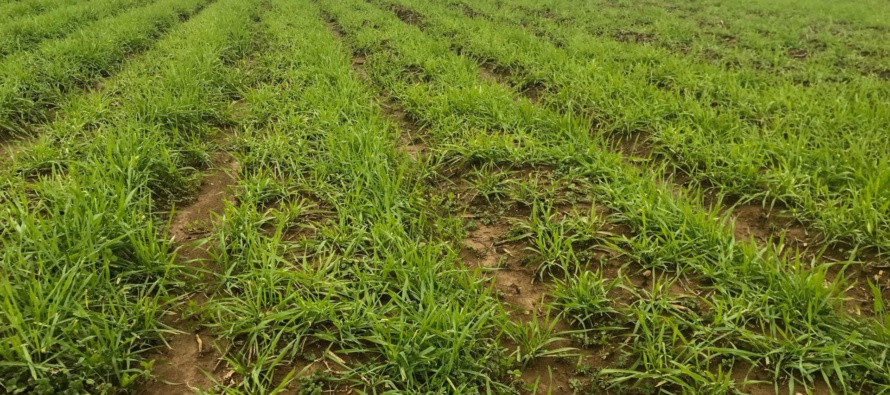Cover Crop Termination and Preparation for Corn Planting

Related Articles
- 2010 Soybean And Corn Variety Trial Data 3
- Spring Nitrogen Fertility Suggestions for Wheat 0
- 2010 Row Crop Short Course Video Links 0
Latest Tweets
Cover cropping is a hot agricultural topic primarily driven by the goal of improving soil health and water quality, but the concept has been around for years. Cover crops produce vegetation which can help protect the soil from erosion, improve soil organic matter and provide other benefits during the winter when traditional summer crops are not grown. However, cover crops ordinarily grow well past traditional spring planting times for primary crops. Thus, cover crops naturally present issues by delaying planting progress, hampering efficiency and competing with primary crops. This interference can greatly reduce crop yields. Accordingly, growers must find a practical management solution between these plant systems, which will require compromise.

Cover crops often interfere with crop emergence and growth, which greatly restricts crop yield and future adoption.
Winter cover crops naturally grow well past optimal spring planting times for primary crops, so terminating them prior to crop planting could potentially address many issues causing interference. However, the extent of the potential benefits associated with cover cropping, such as biomass contribution and nitrogen fixation, will likely be meager if they are terminated too soon. Conversely, profuse cover crop growth greatly increases many problems documented to increase failure.
We have conducted research evaluating methods to incorporate cover crops into successful corn production systems. Corn is the first crop suitable for planting in the spring which stresses the timing conflict with cover crops. Furthermore, corn is also extremely sensitive to emergence failure and plant growth disparity, compared to other primary crops, including soybean and cotton. Cover crop vegetation can aggravate these issues. Therefore, integration of these cropping systems presents considerable challenge.

Cover crop termination timing relative to corn planting date dramatically affected corn productivity. This research is supported by the Mississippi Corn Promotion Board and the Mississippi Corn Checkoff.
Using herbicides to terminate cover crops prior to corn planting is a crucial management factor affecting the successful integration of cover crops. Cover crop vegetation and decaying plant residue not only hindered planter efficiency and stand establishment, but also stunted corn growth and reduced grain yield if cover crop termination timing was delayed close to planting. This was caused by vegetation reducing absorption of solar radiation and limiting soil temperature, which substantially retarded corn seedling growth and resulting development. Herbicide termination treatments were evaluated at two week intervals from six weeks preplant until corn planting. A standard cover crop mixture consisting of cereal rye and berseem clover reduced corn grain yield 8 to 15% (14 to 23 bu/a) when terminated 2 or 0 wk preplant, compared with no cover crop in a traditional stale seedbed system. The cover crop produced similar corn yield as no cover crop when terminated 4 or 6 weeks preplant. Accordingly, we recommend cover crops be terminated at least four weeks prior to planting corn. Furthermore, this research showed corn yield reduction was greater and occurred further preplant for cereal rye, compared to berseem clover. This shows more interference was associated with cereal rye and is likely related to cereal vegetation having high carbon content which is slow to decompose and thus produce complications, compared to legumes.
Another method to limit interference is to manipulate distribution of cover crops relative to the row where corn is planted. Our research evaluated numerous seeding methods which limited cover crop establishment in the intended planting zone or row. This included mechanical tillage treatments which concentrated cover crop seed in the furrow, rather than the row, as well as strip tillage conducted after cover crop establishment, which physically removed cover crop plants within the row. Our results showed cover crop plant distribution managed by various methods did not affect corn productivity when cover crops were terminated with herbicides several weeks prior to planting.
The best method to address most of the primary issues associated with growing cover crops is to terminate them prior to planting the primary crop. This time reduces opportunity for problems to be transferred to the subsequent crop, as verified by the “green bridge” phenomenon. Problems are also strongly related to the amount of vegetation generated. Regardless, cover crops will produce vegetation or residue which can physically obstruct seed placement, soil coverage and water imbibition which hamper stand development. Row crop planters are ultimately designed to function in bare soil. Thus, substantial planter modifications are usually needed to help displace cover crops, which presents a significant challenge. There are a host of attachments which can be added to or replace parts on a planter including coulters, row cleaners and closing systems designed to improve planter performance in cover crops or any high residue situation. The underlining principle of these products is the ability to efficiently cut and remove vegetation from a strip where seed can be planted. Accordingly, effective row cleaners and closing systems generally rely on sharpened wheels or disc blades with deeply serrated angled teeth to cut vegetation, remove it from the planting zone, and close the seed furrow to obtain optimal seed to soil contact. Popular row cleaners relying on spikes or fingers are not primarily intended to cut or remove vegetation anchored in the soil and thus, will likely struggle when used in cover crops.




Let me tell You a sad story ! There are no comments yet, but You can be first one to comment this article.
Write a comment